

European
Nuclear Society
e-news
Issue 6 Autumn 2004
The 6th issue of ENS News will, unsurprisingly, be a reflection of the past three months. The main feature of this bulletin is the text of the lecture Bertrand Barré, president of the ENS, made at the International Conference “50 Years of Nuclear Power” organised by the IAEA held at Obninsk at the end of June/beginning of July 2004. The text is reproduced here with the kind permission of the IAEA. In a separate contribution, the ENS president also reflects on two important recent events: the notable increase of the price of the barrel of oil and the Mihama accident.
“Listening to others” follows its own pace and is therefore only
loosely related to current affairs. In this issue, we’ll have a closer
look at the tricks people can – and do actually – use to make
unattractive data look better than they are.
News from the ENS members include this time a general presentation of SFEN,
the French Nuclear Energy Society and a report on the international conference
organised last September in Sofia by the Bulgarian Nuclear Society. From now
on, we hope to be able to include in each issue of ENS NEWS at least one presentation
of each of the Nuclear Societies member of the ENS.
Space permitting, this issue also features a fairly comprehensive compilation of NucNet News. Some of the pieces of information included are more than two months old but the compilation as a whole provides what we believe to be an interesting reminder of the more significant events of the past quarter.
We would also like to draw your attention to the fellowships to be awarded to a few young scientists in the framework of the World Nuclear University. Before turning to the relevant pages of this e-Bulletin, please note that the deadline for applying is 1st December 2004.
|
|
|
http://www.euronuclear.org/library/public/enews/ebulletinautumn2004/nuclear-reactors.htm

AREVA, France
President, European Nuclear Society
Bertrand.barre@areva.com
Abstract. The evolution of nuclear reactors since the 1942 Fermi experiment can be described along the lines of natural history, with an initial flourish of uninhibited creativity followed by a severe selection process leading to a handful of surviving species, with light water reactors occupying most of the biotope today. The criteria which drove this selection have evolved with time and might not all be relevant in the future. The recent interesting development of Generation IV and INPRO comes from a desire to rationalize and formalize the selection process for the future nuclear systems. Will these attempts be successful? Will “natural” selection still prevail? In any case, in the context of a growing demand for energy for the developing world and of the need to reduce GHG emission, the nuclear reactor “species” is here to stay.
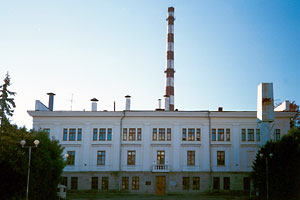
As we are celebrating, here in Obninsk, the “Jubilee”
of Nuclear Power, many presentations will depict the history of nuclear development,
while the bulk of the papers will be devoted to technical status and perspectives
of nuclear systems, reactors and fuel cycles. Having not been myself a main
actor of this development but, rather, a long time privileged witness, let
me try to address the topic under a slightly different angle, and to sketch
the natural history of the phylum “Nuclear Reactor”.
This will lead me to evoke vital ebullience, evolutions and mutations, on
a background of rigorous selection.
There cannot be natural history without some kind of taxonomy, without classifying the species according to more or less arbitrary criteria. Nuclear reactors are usually classified according to the main components of their core: fissile/fertile couple, physical-chemical nature of their fuel, nature of their moderator (or lack of it), nature and thermal-hydraulic condition of the cooling fluid. As the taxonomy is very much diversified, we shall call “species” only those classes comprising a significant number of successive specimens.
Even though there were a dozen of “natural” nuclear reactors operating near what is now Oklo, Gabon, almost two billion years ago, we shall start our natural history only from December 2, 1942, with the CP1 Pile in Chicago, where started the first man-made sustained fission chain reaction.
After the end of the Manhattan Project, and in the “Atoms for Peace” atmosphere, started – essentially in the United States – a period of unbridled creativity, of vital ebullience, which appears hardly credible in retrospect. All the possible reactor types, and again some more, were dreamed, designed, and built, and most of them have actually been operated! All the possible combinations of fissile and fertile materials, of moderators and of cooling fluids
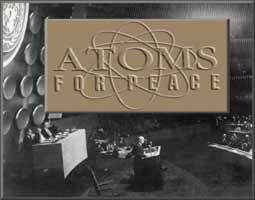
have been tried to build facilities, rather small indeed, and,
let’s admit it, with a relative respect of safety and environmental
impacts. But all these machines have worked, be it for a very limited time,
and without any major accident if one excludes SL1, which might have been
a bizarre suicide. Uranium, plutonium and thorium as metals, oxides, carbides
or more exotic compounds, air and other gases, light water, heavy water, graphite
and beryllium, rods, pins, spheres, particles, suspensions and fluidized beds,
liquid metals and molten salts, everything has been tried at least once between
1950 and 1965 (Table 1). More than 50 different reactors have been built on
the single “National Reactor Testing Station” near Idaho Falls,
now INEEL, and then many more in Oak-Ridge, Hanford, Los Alamos, not to mention
the Kurchatov Institute, IPPE and others.
Table 1. A few of the many possible combinations (Names in bold italic refer
to “species”)

At the very beginning, though, there were not so many possible choices. The
only available fissile material was natural uranium, with its given 0.7% 235U.
To sustain a chain reaction with natural uranium, one had to thermalize as
quickly as possible the fast fission neutrons to avoid their capture in the
resonances of 238U: the reactor could only be heterogeneous and
moderated with light elements. Hydrogen being too absorbent, the choice of
moderator was between heavy water, Graphite or, possibly Beryllium. At the
time, the world stockpile of heavy water (painfully produced by electrolysis
in Norway) was small, while pure graphite was industrially produced in the
USA in quantities for electric furnace electrodes.
Consequently, CP1 had to be what it was: a regular and roughly spherical array
of uranium pebbles (metal and oxide) within a pile of graphite bricks. Hence
the name “atomic pile” which used to designate early nuclear reactors,
while electrochemical piles retain the name of the original Volta pile of
wafers. For the same reasons, a similar design was adopted in 1946 for the
first Soviet reactor, still visible today in the Kurchatov Institute. The
first British pile, GLEEP (1947) was also an array natural uranium/graphite
(with some heavy water as well), while the Canadian and French chose heavy
water D2O to moderate their first reactors ZEEP (1945) and ZOÉ
(1948).
For their first power reactors, while they were developing the technologies for isotopic enrichment, the American continued with the species natural uranium – graphite, with the air cooled Oak Ridge 1 pile (1943), then with the big plutonium production reactors of Hanford, directly cooled by water from the Columbia River. But to leave no stone unturned, they also started in 1944 a D2O moderated pile at Argonne.
Unable to enrich uranium and unwilling to depend entirely from the United States for their fuel supply, the British and the French based the first phase of their nuclear development on “Magnox” and “UNGG” reactors of similar technology, using rods of metallic natural uranium clad in light alloy, disposed in array within a graphite pile and cooled by gas under pressure (air first, then CO2). On the other hand, the Canadian – today the largest uranium producers in the world) stuck with the combination natural uranium - D2O, developing the species “CANDU”.
As soon as the technology for the isotopic enrichment of uranium was developed in the framework of the Manhattan Project, access to enriched uranium, from 1% to 93% freed reactor designers from one of the main constraint which inhibited them, neutron scarcity, and liberated their unbridled creativity. The drivers of this ultra fast initial evolution were the search for more compactness, higher thermal efficiency and better use of the fissile materials.
Low enriched uranium (LEU) around 3% 235U allowed notably to use as moderator ordinary water H2O, the simplest of them all, despite its drawbacks already well known in conventional thermal plants: low boiling temperature under atmospheric pressure and corrosiveness with ordinary steels. In order to get a decent thermal efficiency, one had to use high pressures, typically 7 to 15 MPa.
In order to illustrate this initial creativity, here is a non exhaustive list of reactors built in the USA before 1955:
Natural uranium – graphite plutonium production reactors (Hanford, 1944)
Homogeneous solution in ordinary water of enriched uranium salts (Los Alamos, 1944)
Clementine, Unmoderated sphere of metallic plutonium (Los Alamos, 1945)
EBR 1, Liquid Metal Fast neutrons reactor (Idaho, 1951)
MTR, pool type water reactor with plates of highly enriched uranium alloy (Idaho, 1952)
STR, land based prototype of the Nautilus, first PWR (Idaho, 1953)
BORAX 1, first BWR (Idaho, 1953)
At the same time, the Russian developed a reactor using LEU as fuel, graphite moderated and cooled with boiling ordinary water circulating in pressure tubes. This Obninsk prototype was then the first true power reactor to operate – hence our conference today! – it was also a dual purpose plutonium production reactor, forerunner of the RBMK species.
|
It was to be followed by the MAGNOX reactors of Calder Hall, dual-purpose as well, inaugurated in 1946 by Queen Elizabeth II, by Shippingport, the first power PWR in 1957, then by G2 in Marcoule (1959) and, in 1962, both NPD, ancestor of the CANDU species, and the Windscale AGR prototype. It can be seen that, as early as 1962, a mere twenty tears after the Chicago experiment, all the present “species” were in existence, be it in embryonic form. Finally, in 1966 started the prototypes of what are still today |
would-be species: Dragon, the first HTR, built in Great Britain in the framework of an OECD Project, and the MSRE, molten Salt Reactor Experiment in the United States.
At the end of the 60s, the most advanced western state for the civilian use of nuclear power was Great Britain, the only one to have developed a true species. Several of those early MAGNOX are still in operation. Even more than the difficult development of the AGR species, it is the discovery and exploitation of the North Sea oil fields which have stymied UK’s nuclear development in the 70s and led to the loss of their leadership. As for the United States, in the 60s, their nuclear supremacy was mostly in Defense applications, including a monopoly on naval propulsion and uranium enrichment.
From all the possible designs and the many promising prototypes, we know today that only a handful made it to industrial series, to become what we call here a species. This was not the result of any deliberate process, it was just “natural”, or spontaneous selection. The present operating reactors were, indeed, the fittest to survive; were they the fittest to generate safely and sustainably competitive electric power? This is an open issue…
The drivers of this selection have been various, some positive and some negative. Let’s start with the negative drivers which led to elimination:
Some branches aborted because of technological difficulties (like the lack of compatibility between sodium and graphite in the Hallam reactor), because the project was really overambitious (like the “air breathing” reactor for airplane propulsion), for being too cumbersome (like the natural uranium fueled reactor of the Q 244 submarine), or even due to the choice of one key individual (like the sodium cooled Seawolf, when Admiral Rickhover selected the PWR for all the Navy).
Safety considerations played a more and more significant part in the elimination process. One would not dare, nowadays, submit to any regulatory authority the design of LAMPRE, with its liquid plutonium fuel/coolant; The Windscale fire (1957) eliminated for ever air cooling for graphite reactors, and the Babcock & Wilcox subspecies did not survive the Three Mile Island 2 accident, and nobody would order a new RBMK after Chernobyl. One example illustrate both the safety concern and the energetic methods in use during the pioneer era: to complete a series of reactivity excursion tests in BORAX 1, AEC provoked the deliberate destruction of the reactor in a spectacular vapor explosion after core meltdown (1954). This voluntary accident remains to date the basis for dimensioning the containment of pool type reactors. When one witness the precautions taken to carry out severe accident tests in the PHEBUS-PF reactor, BORAX seems a dream.
We have seen that the mastery of enrichment had made useless the “fine tuning” of the neutron balance required by natural uranium fueled reactors. Similarly, the discovery that uranium was relatively abundant, even though if less rich ores than the initial deposits of Bohemia and Katanga, if enough efforts were devoted to exploration, reduced the competitive advantage for a species to be uranium thrifty. Fast Neutron Breeders have evidently suffered from this evolution which consistently makes them “necessary… but later”. So have the Molten Salt reactors.
In some occurrences, selection may have been a matter of bad luck, bad timing. Such is notably the case for the High Temperature Reactors HTRs, which made a commercial debut in the USA at the beginning of the 70s, just before the rash of cancellations of nuclear plant orders triggered by the first oil crisis. It is, by the way, a very intriguing fact that the same initiator event, the 74 oil shock, launched the French programme while it nearly killed the American programme…

Nuclear power plant with pressurized water reactor
This rather long list should not lead to believe that selection was influenced only by negative factors leading to elimination of such and such competitors: positive factors have also played a key part. To illustrate the point, it is obvious that the emergence of the PWR species was considerably helped by the fact that these reactors had previously be chosen to power the nuclear Navy, because of their compactness, a quality not so essential for land based power plants. They could therefore benefit in the United States from a strong industrial development which allowed Westinghouse to outrun General Electric, its giant competitor. Similarly, MAGNOX, UNGG and RBMK evolved directly from reactors designed and developed to produce plutonium for weapons.
The results of this selection process can be seen on table 2 [11]
| Species |
In Operation |
Construction & Orders |
||
GWe |
# |
GWe |
# |
|
| Magnox, AGR |
11 |
32 |
- |
- |
PWR |
199 |
209 |
8+7 |
9+6 |
BWR |
78 |
92 |
6+5 |
5+4 |
VVER |
33 |
52 |
15+6 |
17+6 |
RBMK |
13 |
17 |
1 |
1 |
CANDU |
21 |
40 |
5+1 |
9+6 |
FBR |
1 |
4 |
3 |
5 |
TOTAL incl ATR |
356 |
446 |
39+19 |
46+23 |
The gas cooled graphite moderated species, once flourishing, was successively abandoned by France, Italy, Spain and Japan. Only survive the British Magnox and AGR, roughly 4% of the installed capacity today, but the most recent reactor operating in the UK is a PWR.
Magnox and the French UNGG used natural uranium as a fuel, but as graphite is a mediocre moderator, the neutron balance was very tight, and they could not afford neutron capture in oxygen. Therefore the fuel was metallic uranium, the melting temperature of which is unfortunately low. They also could afford as few as possible captures in the fission products, a constraint which made on-line refueling compulsory.
The factors which favored its early selection were the possibility to realize them with a relatively unsophisticated technology – the technology of post WWII France – and the combination natural uranium + on-line refueling allowed to use them to produce almost pure 239Pu for military applications without too much interference with their use as power reactors.
Conversely, the factors which led to their elimination was the low volumic power in their core which led to very large facility sizes when the unit power rating started to increase above a few hundred MWe, their sensitiveness to the 135Xe poisoning which limited their flexibility… and their capability of producing weapon-grade plutonium, once proliferation became undesirable.
The AGR were designed by the British to overcome some of the weaknesses of the Magnox: the switch to slightly enriched uranium allowed for an oxide fuel, refractory, which in turn allowed for a factor two reduction in core volume, an increase in the gas exit temperature and an excellent thermal efficiency. Their success was limited by a rather troublesome startup, partly due to bad industrial organization, mostly due to corrosion of steel by the higher temperature CO2. They operate very well today, but too late to save the species: in the meantime, LWR have won the race.
The case for gas cooling is not close, as we shall see when turning to future generations (HTR, GFR), but their first period is over.
The “Big water channel reactor” RBMK was one of the two nuclear workhorses of the former Soviet Union, limited to Russia, Ukraine and Lithuania. Fuel bundles of low enriched uranium oxide are cooled by boiling water circulating in pressure tubes vertically inserted in a massive graphite pile.

Principle of a nuclear power plant with boiling water reactor
The initial factors of success of this species were identical to the precedent: accessible technology and dual purpose (electricity and weapon-grade plutonium). This latter quality restricted their use to the Soviet Union proper and only VVR were exported to the other countries of the then “Eastern Block”.
The reason for their progressive elimination has one name: Chernobyl (even though later improvements have significantly reduced their instability domain).
CANDU (for CANadian Deuterium Uranium) is today the only species maintaining an active niche in a Light water dominated world. From a pure neutron physics point of view without cost considerations, heavy water is the best possible moderator. Using D2O as both moderator and coolant, CANDU can be fueled with natural uranium oxide and reach significant burnups. The fuel bundles, on-line refueled, are cooled by pressurized heavy water circulating in horizontal pressure tubes. Heavy water must be periodically re-enriched and de-tritiated.
The Canadian exported CANDU in many countries (India, Pakistan, South Korea, Argentina, Romania and China) based on the following factors: accessible technology (pressure tubes are easier to manufacture than big pressure vessels), no dependence from a very limited number of uranium enrichment suppliers, and smaller sizes as they offer 300 and 600 MWe plants where most LWR are rated 1000 MWe and above.
On the negative side, specific investment is high and heavy water is very expensive, but fuel cycle costs are low. On-line refueling allows for high availability, but, together with natural uranium, it also makes it technically easy to produce weapon-grade plutonium.
In term of installed power, PWRs alone account for more than half the world nuclear capacity; together, the three LWR “cousins” cover more than 85% of the market. LWR really dominate the reactors biotope. In reality, this domination is even more absolute, as most of the reactors used for naval propulsion are small PWR (their thermal rating of the order of 100 MWth instead of 3000),
As ordinary water is the best to slow neutrons down, the cores are compact. On the other hand, water is absorbent and LWR must used a fuel with significant concentration in fissile isotopes, typically 4% 235U or 8% plutonium, refueling being off-line. Even with high pressure in the primary circuit, these reactors have a mediocre thermal efficiency (~35%) and a rather low conversion factor, around 0.6. But they are sturdy and more flexible than initially expected. Relatively large unit are, in most countries, quite competitive to generate baseload power [15-16], even without any credit for carbon emission.
In addition to the intrinsic qualities mentioned above, the key factors for this immense success were the technology transfer from submarines to power plants, the sheer power of the American industry in the western world in the 60s and 70s, and the driving force of a then huge nuclear power programme in the USA. Among a number of reasons behind the French switch from UNGG to the “American” species was: “because everybody else chose them” – even though we are expected to cultivate the French exception. “Vive la difference”, as the British use to say.
To complete the selection story, one should also mention High Temperature Gas-cooled Reactors HTR which almost made it as a full fledged species in the 70s, and Sodium-cooled Fast neutron Breeder Reactors doing the same in the 80s. Both had some very specific advantages which will probably lead to their “resurrection” ,as we shall see below, but in both cases, the attempt proved to be premature.
The LWR species will continue to dominate in the near future. With one exception
all “Generation III” reactors are LWRs: the already ordered ABWR
and EPR plants and projects like AP1000, ESBWR, VVR640, SVR100, APWR, etc.
The only exception, the ACR 750 project, is no longer a pure CANDU,
as it would be cooled by ordinary water and fueled by low enriched uranium…

In nature, the success of one species makes it very difficult for competing species to penetrate the same ecological niche. Without the massive extinction of the dinosaurs, would the mammals have thrived? Would one of their branches evolved into Man? The same applies in the reactors phylum: construction facilities are made to build LWRs, fuel cycle facilities are optimized for LWRs, nuclear R&D is devoted in majority to LWR improvements, and most Safety authorities around the world “think” LWR. I am not sure it is true that one NRC staff member once asked where was the emergency water injection system in gas-cooled Fort St Vrain, but the story is credible. I know for a fact that one of the heaviest constraints imposed on sodium-cooled Superphénix, the hypothesis of guillotine double break of the largest secondary piping, came only from some kind of PWR contamination.
One can reasonably ask if there is room for any other species than PWR and BWR. Both technologies are close enough to co-exist without problem, and both are different enough to respond to the desire for a minimum diversification which may explain today’s CANDU niche. Shouldn’t we simply go on improving these two species?
Let’s put it another way. No new candidate species will find a niche unless it exhibits a significant advantage in at least one of the domains where LWRs have an undisputed weakness. But the very notions of advantage and significant can vary with time! Witness the automobile:
In the beginning of the motor car technology, there was also a flourish of creativity, and the future dominance of the internal combustion engine over its electrical and steam driven competitors did not occur overnight. The first automobile to break the 100 km/h barrier was an electric car, the Jamais Contente of C. Jenatzy, in 1899, performance that we could equate with the first electricity production by the Fast Neutron reactor EBR1 in 1951. In 1906, the world speed record belonged to a steam car which reached 196 km/h! But a key factor established the success of the internal combustion engine: the unmatched autonomy offered by the gas tank. To push the comparison to its limits, one can remark that internal combustion engines exist in two varieties, gas and diesel, as close and as different as PWR and BWR. Today, the electric car survives on a niche (apart from its railroad avatar, the TGV). It was, however, as soon as 1900, obvious that the electric car was very superior to its competitors in terms of atmospheric pollution and noise. At the time, those undisputed advantages were not significant, but winds are changing nowadays. The environment which allowed for the dominance of the LWR species may also be evolving.
It is precisely this kind of thinking which explains the two very interesting initiatives, launched just at the turn of the century. At any given moment, and considering objects whose lifetime (from design to dismantling) spans the century, the weight of the existing species hinders all attempts to make significant breakthroughs. Even the so-called “revolutionary” advanced LWR designs, which exhibit rather modest changes in the basic LWR technology, meet some diffidence from many regulators, because they are – factually – loosing part of the return of experience from their forerunners. Obviously, any breakthrough, any introduction of a brand new reactor species must be prepared decades in advance. With this kind of delay, one can hope to design not only “reactors”, but nuclear systems better suited to the selection criteria of the 2040s, which may not be identical to the criteria which led to the present selection.
Philosophically, this is a real change. Instead of designing reactors optimized for today’s market – as Generation IV, one tries to anticipate what the market will be four decades from now, to imagine the best possible concepts to answer these faraway demands and to launch today all the actions necessary, R&D and beyond, to make this desired future possible. Actually one tries to replace the past “natural” spontaneous selection by a formalized process.

At the initiative of the USDOE, since 1999, ten countries have worked together to select a few model concepts for future nuclear systems, and to define and perform the R&D necessary to make them ready for possible commercialization after 2030. Criteria for formal selection included Sustainability (fissile resources utilization, waste minimization, proliferation resistance and physical protection), Safety & Reliability (radio-protection, reactivity control, heat removal, mitigation features) and Economics. A first phase was open to the unbridled creativity which led to revisiting all former reactor designs and inventing a few more. The result was a list of roughly 120 concepts. Then, within the Generation IV International Forum, each concept was passed through the sieve, and six of them survived the ordeal. The six model concepts finally selected are:
Supercritical Water Cooled Reactor System SCWR;
Very High Temperature Reactor System VHTR;
Sodium Cooled Fast Reactor System SFR;
Lead Alloy Cooled Fast Reactor System LFR;
Gas Cooled Fast Reactor System GFR;
Molten Salt Reactor System MSR.
I shall not describe these concepts in detail, as many papers in this conference are devoted to them. But there are a few comments worth making:
All these systems do not have same timeframe for development. One could reinvent Superphénix – or, rather its successor design EFR – in little time. The VHTR and SCWR could be developed at the prototype level rather quickly. The GFR is farther away, and the MSR even farther (some GIF participants do not even include it).
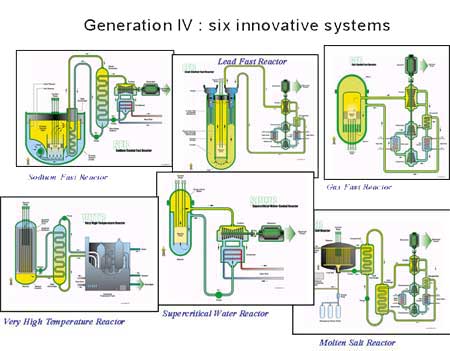
The weight of the “sustainability” criteria appears in the fact that at least 4 and possibly 5 of these systems are based on closed fuel cycle to better use the fissile natural resources, 3 of them being fast breeders.
The VHTR and (later) the GFR target not only the generation of electric power
but the co-generation of power and hydrogen with the aim to make transportation
fuels from fission power. This is certainly necessary if we want nuclear power
to contribute very significantly to the reduction of greenhouse gases emissions
on a world scale.
Finally the future may not be limited to these 6 species. Some intriguing
concepts are developed like the AHTR, a molten salt-cooled HTR. Some teams
keep working on the Accelerator Driven subcritical systems, the niche of which
could be the transmutation of minor actinides, if deemed useful at some point,
etc.
In 2000, the IAEA initiated the INPRO Project in which fifteen (now eighteen) member states have worked to define "User Requirements" for innovative nuclear energy systems in the area of Economics, Sustainability and Environment, Safety, Waste Management, Proliferation Resistance and some cross-cutting issues. The time horizon of this exercise is 2050. They have also developed a methodology of assessment for such systems. Phase 1A of INPRO was completed in June 2003, and the methodology is being tested on a 6 “national cases”. Started entirely as an extrabudgetary initiative, INPRO is now partly funded by the Agency regular budget.
Based on similar analyses and motivations, the works of GIF and INPRO are not identical: GIF partners are mostly suppliers, and their work will steer the R&D, whereas INPRO expresses mostly the requirements of potential future users. Each group is quite aware of the other's results, and they have worked in cooperation on some issues (like proliferation resistance).
For fusion, it is too early to see if the “natural history” approach is relevant. ITER, the big international facility about to be built, might not yet be the true equivalent of the December 1942 CP1 experiment which was our starting point… One can nevertheless remark that from a flourish of early configurations (Yin-Yang, stellarator, Z-pinch…) the Tokamak species dominates today fusion’s prehistory. I am referring only to Magnetic Confinement Fusion, because ICF does not seem to offer promising prospects for power generation.
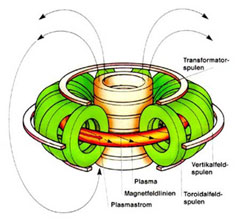
Tokamak principle
From 0 TWh 50 years ago to some 2 600 today, more than the equivalent in primary energy of the oil production of Saudi Arabia or Russia, nuclear power has come a long way. This is where the “natural selection” has led us but this is not enough.
In the next 50 years, the most dramatic problem which we must address is probably the Energy/Climate Dilemma. One third of the 6 billion people with whom we share this planet Earth have not enough energy to lead a decent life, under any modern standard. Within fifty years, mankind will number 9 billion. Even under the most optimistic assumptions concerning increases in energy efficiency and “thrifty” development, primary energy demand will then reach at least the double of the present 10 billion tons of oil equivalent we consume every year.
On the other hand, it is scientifically established that, since the industrial revolution, we have managed to significantly affect the composition of our atmosphere, where the concentration in greenhouse effect gases (GHG) is today twice higher than the level the Earth has ever experienced since the dawn of Man. There is still some residual controversy about just how much of the global warming which occurred throughout the XXth century is due to this proven increase in GHG concentrations, but the best computer models run by the IPCC teams throughout the world agree: at least half of the warming was due to the increase in greenhouse effect. And what those models tell us about our XXIst century is far from reassuring. Any precautionary principle would require that we cut our GHG emission by half.
To complete the picture, 80% of the primary energy we use today comes from the fossil fuels, Oil, Coal and Gas, the combustion of which is the main source of GHG releases. This value of 80% takes into account the 10% coming from (non commercial) traditional biomass which remains the only source of energy for some 2 billion people today.
To face this tremendous challenge, there is no “magic bullet”, not even the nuclear bullet. We shall have to take all the measures we can take, and then some more…
We must address the demand side and not only the supply side of the equation. We must limit our energy consumption, increase our energy efficiency, and conserve energy. This applies first and foremost to our presently industrialized economies in the OECD, but the emerging giants, China, India, Brazil to name the biggest, must also find thrifty development paths, because of the sheer weight of their demography.
We shall have to “sequester” CO2 whenever and wherever technically feasible. The development of sequestration is still in its infancy, and the long-term safety assessment of disposal sites will not be much easier than that of radwastes, but I do not believe we can do without it.
We must increase in our energy mix the share of non GHG-emitting sources, namely nuclear power, hydropower and other renewables.
It is my firm belief that to tackle such a problem, all those measures will be necessary. It would be dramatically unrealistic to hope to succeed without a significant increase in the contribution of nuclear power: for electricity generation, of course, but later for other uses like water desalination, process heat, hydrogen production…
Let us hope that the formalized selection process which the nuclear community is attempting presently will prove efficient, and allow nuclear power to meet our hopes.
[1] Alvin M. Weinberg. The First Nuclear Era / The life and Times of a Technological Fixer. AIP Press 1994
[2] John W. Simpson. Nuclear Power from Underseas to Outer Space. ANS 1995
[3] Controlled Nuclear Chain Reaction: The First Fifty Years. ANS 1992
[4] Bertrand Goldschmidt . L'Aventure Atomique, Fayard 1962
[5] Bertrand Goldschmidt. Les Rivalités Atomiques 1939-1966 Fayard 1967
[6] Bertrand Goldschmidt. Le Complexe Atomique Fayard 1980
[7] Bertrand Goldschmidt. Pionniers de l'Atome. Stock 1987
[8] Jacques Leclercq. L'Ere Nucléaire. Hachette 1986
[9] L'Aventure de l'Atome. Flammarion 1992
[10] Repères chronologiques de l'histoire du nucléaire 1896-1995. CEA 1998
[14] ELECNUC – Les centrales nucléaires dans le monde, CEA/DES/SEE 2002
[15] Les coûts de référence de la production électrique. DGEMP France 2003 (www.industrie.gouv.fr)
[16] S. Rissanen, R. Tarjanne, University of Lapaarenta, Finland 2004
[17] INPRO, IAEA Tecdoc 1362. 2003
[18] The Roadmap to Generation IV. GIF 2003
http://www.euronuclear.org/library/public/enews/ebulletinautumn2004/general-assembly-1104.htm

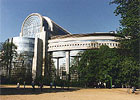 |
ENS has taken the habit of organising its autumn meetings in Brussels: Board Meeting on Tuesday 23 November 2004 and General Assembly on 24 November 2004. Further details are available from the members’ pages on the ENS web site. |
http://www.euronuclear.org/library/public/enews/ebulletinautumn2004/listening.htm


The use of the word “creative” in the title of this article is inspired from the well-established phrase “creative accounting”. According to Wikipedia, an Internet encyclopædia, creative accounting refers to accounting practices that deviate from the standard ones. In particular, it can be used to refer to systematic misrepresentation of the true income and assets of business organisations.
As we shall see shortly, creativity in this sense is not restricted to accounting.
My attention was recently drawn to a graph published in January 2004 by the
American magazine Windpower Monthly1. The said graph purported
to plot the price of wind power against coal, gas and nuclear. Its objective
was to show that wind energy is becoming competitive with the cheapest non-renewable
energy sources. One would think that this is a tall order. Not if you have
sufficient imagination. The way in which the task was tackled makes it worth
while analysing. Since I do not wish to infringe any copyrights, I shall proceed
in three steps using my own graphs. First, one must prepare a bar chart showing
the price ranges in $/MWh for the three non-renewable energy sources. Energy
sources 1, 2 and 3 are supposed to stand for gas, coal and nuclear respectively.
Here already, one might question the figures chosen: no source is given for
the price ranges considered. They might apply to the US context, but are certainly
not valid for EU countries, as testified by numerous studies and the recent
Finnish decision to build Finland 5. I shall not spend more time on this issue
in order not to deviate from the point I am trying to make. Let us just note
that gas would come out cheapest and nuclear most expensive, both as regards
the bottom and top ends of the ranges, as shown in fig 1.
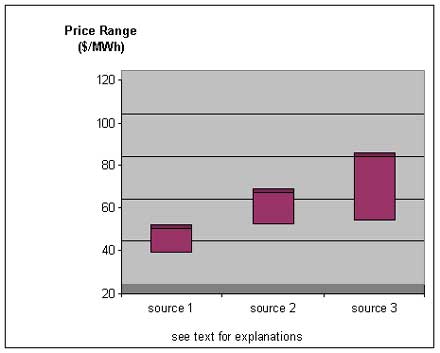
figure 1
One then proceeds to plot the cost of energy produced vs. the wind speed.
It can be easily shown that the energy converted into electricity E is proportional
to the third power of the wind speed. If we consider that the only generation
cost involved is the investment needed to build the wind machine, then the
cost per MWh produced c is equal to this investment divided by E. This entails
that cost c is inversely proportional to the third power of the wind
speed. Such relationship explains why cost c decreases rapidly when the wind
speed increases, as shown in fig 2.

figure 2
Now comes the last and most interesting part of the exercise.
Since the unit cost of wind electricity also varies in the present case, one
just has to call it price range. One is then able to take advantage of the
commonality of the variable plotted along the vertical axis to combine the
two graphs into a single picture.
Before doing so however, the truly creative person will however tilt the bar
chart at a suitable angle so as to enhance the impression of escalating costs
with the non-renewable energy sources. The final result is shown in figure
3.
 |
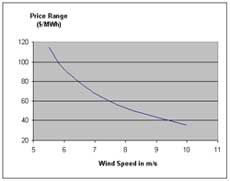 |
figure 3
Putting the two graphs side by side then enables one to claim that with an average wind speed above 8 m/s, wind electricity competes cost-wise with the best gas plants.
It might be true that the best wind farms deliver electricity
that is less costly than the electricity produced by the best gas plants.
Decisions however are not made on the basis of the exceptional, but on the
basis of the likely. And the least one can say is that the likely is not to
be found in figure 3.
On the non-renewable side, price ranges have been displayed to translate the
impact of the variation of a large number of parameters (erection and maintenance
costs, fuel price, discount rate, etc.) on the cost of electricity.
What has been done on the wind side is quite different: one has plotted the
consequences in money terms of the physical law linking the energy produced
to the wind speed. Had one treated wind in the same way as the non-renewables,
one would have obtained something similar to figure 4. The cheapest wind electricity
would still beat the best performing plants using non-renewable energy sources
(assuming the figures used are reliable), but the true message depicts a much
more complex reality than in figure 3.
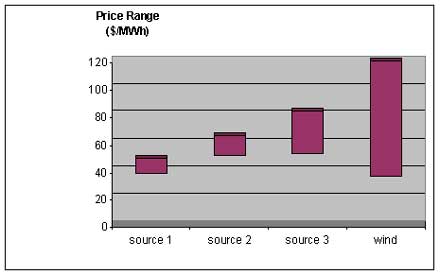
figure 4
Overlooking the fact that the optimal wind conditions are actually in short supply, both time-wise and space-wise further skews the comparison.
The worst in my view however is that the “clever” layout adopted for figure 3 will lead the non-specialists to associate non-renewables with high costs and wind energy with low costs. Things are far from being that simple: if wind energy was so cheap, why not go for 100% wind electricity? In a similar vein, just swap the positions of sources 1 and 3 in figure 3: what is left from the “demonstration”?
It is a pity that the wind industry tolerates such pieces of inaccurate reasoning in its reports. Due to its intermittent nature, wind energy absolutely needs to be backed up by steady energy sources. Among them, nuclear is the only one that, like wind, does not generate carbon dioxide. The case of wind energy only confirms the validity of the energy mix concept and the need to include nuclear in the said mix.
Let us nevertheless conclude on a more positive note. Next time your neighbour
tells you it’s now been established that wind power is competitive with
the best non-renewable power plants, you’ll know why (s)he might be
absolutely sincere.
1 A copy of the graph can be found on the Internet on page 73 of “Wind Force 12” (http://www.ewea.org/documents/WF12-2004_eng.pdf), a report published in May 2004 by the European Wind Energy Association (EWEA). To be complete, it must be added that the cover page of the document also bears the Greenpeace logo.
http://www.euronuclear.org/library/public/enews/ebulletinautumn2004/nuc-pow-bulgaria.htm

The conference was held from 23 till 25 September 2004 in Sofia, at Grand Hotel Sofia. One hundred forty-one Bulgarian participants took part in the International Conference. They included representatives from the Bulgarian Parliament, the Bulgarian Government, universities, scientific institutes, and organisations from the nuclear energy industry. There were also 30 foreign participants from Russia, the Czech Republic, Germany, France, etc.
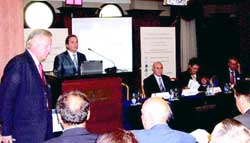
About 40 reports were presented at the conference by leading Bulgarian and foreign scientists and experts. Among them, there were reports of organisations from the above-mentioned countries, all of which are candidates for the construction of Belene NPP. New views on the world-wide development of nuclear energy were also presented.
A press conference and a round table on the Preparation and Training of Personnel in the Nuclear Energy Field were held on 24th September. A visit to the Belene NPP site on 25 September concluded the event.
In a press statement, the Bulgarian Nuclear Society summarised its position as follows.
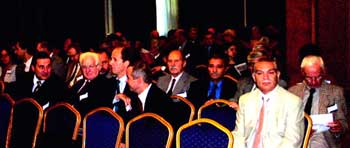
“The interest of the Bulgarian public in the development of nuclear energy is understandable, as it is a well-mastered, cheap, and environment-friendly technology for electricity production. This interest is additionally strengthened by the unacceptable perspective for closure of Units 1-4 of VVER-440 type, as well as by the long-lasting unclear status of the NPP in Belene, whose construction began in 1981.”
http://www.euronuclear.org/library/public/enews/ebulletinautumn2004/sfen.htm

A non-profit organisation founded in 1973 gathering 4000 individual members committed to the advancement of nuclear energy applications in the technical, economic and social, national and international arenas.
Scientific, technical and economic activities for the development, maintenance and transmissions of competencies
Information and communication activities vis-à-vis the decision makers and the public in general on local, regional, national, european and global level.
International activities for the creation and maintenance of an international network of contacts and the diffusion of French technical know-how and competencies.
10 technical sections: Teaching, Training; Material science and technology; non-destructive testing; safety and environmental protection; nuclear fuel cycle; reactor physics; reactor technology and operation; energy issues, nuclear energy economics and finance; law and insurance; waste and decommissioning.
One group on reflections and prospective for energy in the 21st century.
One network of 23 regional groups, one “Young Professionals” Group), one “Women in the Nuclear” Group, as well as 15 Student Groups.
Within the European Union, the French Nuclear Society work with two organisations, the European Nuclear Society (ENS), and the European Atomic Forum (Foratom). They maintain relationships with the OCDE Nuclear Energy Agency (AEN) and the International Atomic Energy Agency (IAEA).
Outside of Europe, the French Nuclear Society has signed 8 bilateral agreements with foreign nuclear societies (Canada, China, Korea, Japan, Russia…) and through the French Section of the ANS it maintains close links to the American Nuclear Society.
A monthly bulletin (newsletter), a bi-monthly technical magazine, an internet site, specialised publications.
The organisation of technical colloquia, conferences – debates, visits to nuclear facilities and the numerous contacts in the world of secondary school teachers, college and university professors and students…
16 one-day topical meetings, gathering more than 1000 participants (e.g. on Probabilistic Safety Assessments, radioactive waste, “N4”-type nuclear power plants, new legal concepts)
1 international congress with more than 300 participants, organised in Avignon on the decommissioning of nuclear installations.
33 debates on nuclear and energy politicies organised in Paris and in the French regions in connection with the National Energy Debate.
15 articles or columns published in the main regional and national newspapers.
A “General Declaration” and five proposals formulated in the a press conference taken up in several local meetings and widely circulated to elected officials.
Meetings featuring speakers from all fields of expertise, such as MM. Hubert Reeves, Pierre-René Bauquis, Professors Jean-Claude Artus, André Aurengo, Jean-François Lacronique, Deputies Nathalie Kosciusko-Morizet and André Sentini, Mrs Nicole Notat and others.
The National Convention will gather 250 participants on the theme of Reactors of the Future.
The National Convention focussed on the new technologies and new competencies for nuclear plants in operation (9-10 March 2004 in Paris).
The launch of a special action aimed at transferring competencies to, and integrating, young professionals.
The will to reach 500 secondary school teachers, college and Technical University professors through general information meetings on the nuclear industry and presentations to thousands of students from secondary schools and institutions of higher education.
Involvement of “La Revue Générale Nucléaire”, The General Nuclear Review, in a co-operation project at European level with the German and Spanish nuclear magazines.
Workshops on the EPR, graphite waste, gas reactors, non-destructive testing, safety…
A Franco-Chinese seminar in Beijing, China and a Franco-Korean seminar in Seoul, Korea


To find out more and register, visit http://www.ena2004.org/.
Rising oil prices. The drive to curb greenhouse gas emissions. Worries about security of energy supply. These are the realities for policy-makers and industry - and the pressure is ON.
Against this background, what role can nuclear energy play in helping Europe to meet its economic and environmental objectives?
This is the key question to be addressed at the forthcoming European Nuclear Assembly (ENA), a high-level conference organised by the European Atomic Forum (FORATOM), taking place at the prestigious Conrad Hotel in Brussels on Thursday and Friday 25 and 26 November.
The ENA will be THE opportunity to witness and take part in a lively exchange of views between energy experts on a crucial issue facing all Europeans - the future use of nuclear energy for power generation in the EU.
Leading the debate will be prominent MEPs and high-ranking officials from the European Commission. Top industrialists from Europe's major energy companies will also present their views during discussions moderated by energy specialists.
Visit the conference website now to secure your place at this important meeting.
http://www.euronuclear.org/library/public/enews/ebulletinautumn2004/world-nuclear-university.htm


Applications will soon be invited for an exciting new opportunity in the realm of nuclear education: The World Nuclear University (WNU) Fellowship. A fellowship "Offering a unique career building experience for future world leaders in nuclear science and technology".
The new WNU Summer Institute providing this fellowship is the first of its kind held by the WNU, established in the autumn of 2003, and so itself relatively new.
From as many as 30-countries, some 60-WNU Fellows selected from among the world's top nuclear students and leading young professionals will participate in a unique and intensive 6-week training experience from 9th July – 20th August 2005.
Some of the world’s most prominent figures in Science, Engineering and Environment will lecture on the course. The training will cover a wide variety of nuclear energy issues, team-building and leadership exercises with a view to developing a growing global network and future leaders in the nuclear profession.
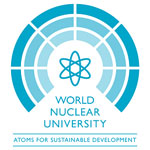
The curriculum for WNU Fellows will include presentations from leading world experts on a broad spectrum of topics relevant to the future of nuclear technology:
Global Setting – Including energy supply and demand, global warming and climate change, sustainability, public acceptance and key political issues and trends.
International Regimes – Including safety, non-proliferation and security, waste management, transport, nuclear law and control of global emissions.
Technology Innovation – Including next generation reactors, advanced fuel cycle, hydrogen production and desalination.
Nuclear Industry Operations – Including industry economies, knowledge management, fuel market, comparative risk assessments, social ethics and operational excellence.
The presenters will include leading nuclear and environmental scientists, industry experts, authors and policy makers. Most notably among them will be Hans Blix, WNU Chancellor and James Lovelock, renowned global environmental scientist and author of Gaia Theory.
In order to qualify for the WNU Fellowship, Candidates/Applicants should have:
Master’s level or equivalent experience in science or engineering, with a knowledge of nuclear fundamentals;
Demonstrated academic or professional excellence;
Proficiency in English, particularly oral communication; and
A maximum age of 32, though exceptions will be considered on the basis of outstanding merit.
In late October 2004, WNU Fellowship applications will be circulated/distributed to UN Missions in Vienna, to Member Companies of WNA and WANO and to institutions involved in the WNU network. The deadline for WNU Fellowship application is 1st December 2004.
The selection process of WNU Fellows will be made through consultation, led by the WNU Coordinating Centre which includes the Founding Supporters and Country Representatives in the WNU partnership network. The desire/aim is that an internationally diverse mix of top students and young professionals from/in government or the nuclear industry will be successful.
Accreditation for the Fellowship will take the form of a certificate and such academic credit as may be awarded by a Fellow’s own educational institution.
The U.S. Department of Energy has kindly agreed to host this first WNU Summer Institute at the Idaho National Laboratory (the designated technology innovation centre for the American nuclear renaissance).
WNU Fellows will occupy hotel rooms near Idaho Falls during the course and will visit the Idaho Nuclear Reservation (during the 6-weeks).
A fixed tuition fee of approximately 9,500 dollars will cover the cost of all course work, housing and food, although this figure does not include travel expenses.
Fellows from government and industry will be expected to cover their own expenses, while applicants from developing countries should be eligible for IAEA assistance. The WNU budget may provide top up funds where necessary.
Future venues for the WNU Summer Institute are to be decided.
As the Summer Institute of the WNU evolves, so, it is hoped, will the mission of the WNU be further realised:
“To elevate the prestige of the nuclear profession and
to develop and
inspire a new generation of leaders in nuclear technology worldwide”.
_______________________________________________
Source: World Nuclear University
Atoms for Sustainable Development
http://www.euronuclear.org/library/public/enews/ebulletinautumn2004/nucnet-news.htm


Electrabel Board Requests EPR Study: Belgian utility Electrabel
has announced that its board of directors, during an energy-policy meeting
yesterday, requested management “to pursue the necessary contacts and
studies that will eventually make it possible to have nuclear capacity of
the EPR (European pressurised water reactor) type under the most favourable
economic conditions”. No. 187 / News; 29.09.2004.
________________________________
IAEA Resolutions Offers Widespread Support For New Technologies: The International Atomic Energy Agency (IAEA) has given strong support to the development of new reactor and fuel cycle systems by adopting a resolution stressing the need for “international collaboration for the development of innovative nuclear technology”. No. 186 / News; 24.09.2004.
________________________________
New US Study Points To ‘Competitive’ Prospects For N-Power: A new US study into the economic competitiveness of nuclear power suggests that projected future costs associated with nuclear electricity generation are comparable with gas and coal-based generation. No. 184 / News; 20.09.2004.
________________________________
Royal Society President Says UK Needs ‘More Nuclear Power Stations: The truth is that it will be difficult for Britain to lead the way on climate change in the mid-term future without building new nuclear power stations”, says Lord Robert May of Oxford, president of Britain’s Royal Society, the UK national academy of science, and chief scientific adviser to the UK government in 1995-2000. No. 182 / News; 16.09.2004.
________________________________
NRC Approves Design Of Westinghouse AP1000 Reactor: The US Nuclear Regulatory Commission (NRC) yesterday announced that it had issued a final safety evaluation report and final design approval (FDA) for the Westinghouse AP1000 advanced reactor design – and that the approval is good for five years. No. 179 / News; 14.09.2004.
________________________________
Nuclear Debate Sparks Interest At World Energy Congress: Chairing the session “Nuclear Energy: inevitable or Irrelevant?” yesterday at the 19th World Energy Congress in Sydney, Australia, Nuclear Energy Agency (NEA) director-general Luis Echávarri said: “This debate on nuclear energy could not be timelier – the coming years will be crucial in determining what contribution nuclear energy will make to the world energy supply and to sustainable development.” No. 177 / News; 09.09.2004.
________________________________
EC Announces Revised Nuclear Package Proposals: The European Commission has announced revised versions of two proposed directives on nuclear installations safety and radwaste management – and called for them to be discussed “without delay” by EU leaders. No. 176 / News; 09.09.2004.
________________________________
IAEA Reports On 2003 And Updates On ‘Fastest Growth In Asia: The International Atomic Energy Agency (IAEA) says it continued to expand its scope of activities in 2003 – a year that marked the 50th anniversary of US president Dwight D Eisenhower’s “Atoms for Peace” speech – and that Asia continues to be the centre for nuclear expansion and growth prospects. No. 167 / News; 27.08.2004.
________________________________
US And France Sign Agreement On R&D And Phenix: US energy secretary Spencer Abraham yesterday signed an agreement with French atomic energy commission (CEA) chairman Alain Bugat to allow cooperation between the US Department of Energy's (DOE) Office of Nuclear Energy, Science and Technology and the CEA – and to provide the DOE with access to France’s Phenix prototype fast breeder reactor, which the DOE said “has a capability that no longer exists in the US”. No. 166 / News; 25.08.2004.
________________________________
Ukraine’s Khmelnitsky-2 Connected to Grid: Ukraine’s
new nuclear power unit, Khmelnitsky-2, was connected to the national grid
for the first time at approximately noon yesterday – during a ceremony
attended by the country’s president, Leonid Kuchma, and fuel and energy
minister Serhiy Tulub. No. 159 / News; 09.08.2004.
________________________________
Russia Completes Design Work For New Fast Reactor: Russia’s Research Institute for Atomic Reactors (RIAR) in Dimitrovgrad has completed design and preparatory work for a proposed new fast reactor to replace its BOR-60 (BOR – fast experimental reactor) which is nearing the end of its design life. No. 157 / News; 30.07.2004.
________________________________
UK Sets Out Future Strategy For Radwaste Management Body: The British government said yesterday that a new state-owned “company limited by guarantee” (CLG) is being set up to hold shares in the UK’s Nuclear Industry Radioactive Waste Management Executive (Nirex), and oversee its business operations. No. 153 / News; 22.07.2004.
________________________________
NRG To Study New Nuclear In The Netherlands: Nuclear Research and consultancy Group (NRG) has announced it will launch a study next month related to the introduction of new nuclear capacity into the Dutch energy market. No. 151 / News; 20.07.2004.
________________________________
India To Use Waste Heat From Reactors For Desalination: India is planning to use waste heat from some of its nuclear reactor units for desalination, including a facility to produce 500 cubic metres of desalinated water a day utilising heat from a proposed advanced heavy water reactor (AHWR). No. 149 / News; 16.07.2004.
________________________________
Russian President Pledges Support For ‘Development’ of IAEA: President Vladimir Putin said yesterday that Russia was committed to supporting the development of the International Atomic Energy Agency (IAEA) and that he hoped the agency’s activities would be expanded. No. 144 / News; 01.07.2004.
________________________________
France’s EDF Gives Go-Ahead For EPR Reactor
Development: The Electricité de France (EDF) board of directors
on 22nd June authorised the launch of the process leading to the construction
of a demonstration unit of the European pressurised water reactor (EPR) –
while related energy legislation continues to make its way through the French
parliament. No. 137 / News; 24.06.2004.
http://www.euronuclear.org/library/public/enews/ebulletinautumn2004/member-societies.htm

| Austrian Nuclear Society |
Belgian Nuclear Society |
| British Nuclear Energy Society |
Bulgarian Nuclear Society |
| Croatian Nuclear Society |
Republic Czech Nuclear Society |
| Danish Nuclear Society (DKS) |
Finnish Nuclear Society |
| French Nuclear Energy Society (SFEN) |
German Nuclear Society (KTG) |
| Hungarian Nuclear Society |
The Israel Nuclear Society |
Italian Nuclear Association |
Lithuanian Nuclear Energy Association |
| Netherlands Nuclear Society |
Polish Nuclear Society |
Romanian Nuclear Energy Association (AREN) |
Nuclear Society of Russia |
Slovak Nuclear Society |
Nuclear Society of Slovenia |
Spanish Nuclear Society |
Swedish Nuclear Society |
Swiss Nuclear Society |
Yugoslav Nuclear Society http://www.vin.bg.ac.yu/ YUNS/index.html |
http://www.euronuclear.org/library/public/enews/ebulletinautumn2004/Corporate-Members.htm

Links to ENS Corporate Members
|
| Aare-Tessin AG (ATEL) |
Alexandrov Research Institute of Technology (NITI) |
| Ansaldo Nucleare – Divisione di Ansaldo Energia
SpA |
Advanced Measurement Technology Inc. |
| Andritz AG |
SPE Atomtex |
| Belgonucleaire |
BKW FMB Energie AG |
| BNFL |
Belgatom |
| CAE Inc. |
Centralschweizerische Kraftwerke (CKW) |
| Chubu Electric Power Co. |
Comisión Chilena de Energía Nuclear |
| Cybernétix Group |
CCI AG (formerly Sulzer Thermtec Ltd) |
| Colenco Power Engineering AG, Nuclear Technology Department
|
Commissariat à l’Energie Atomique (CEA),
Nuclear Energy Division |
| NV Elektriciteits-Produktiemaatschappij Zuid-Nederland
EPZ (Electricity Generating Co. Ltd in the Southern Netherlands) |
EnBW Kraftwerke AG |
| Energie Ouest-Suisse (EOS) |
E.O.N Kernkraft GmbH |
| Euro Nuclear Services BV |
ENS Nuklear Services GmbH |
| Electrabel, Generation Department |
Electricité de France (EDF), Communication Division
|
| Elektrizitäts-Gesellschaft Laufenburg
AG |
Empresarios Agrupados AIE |
| ENUSA Industrias Avanzadas SA |
EXCEL Services Corporation |
| FBFC (Framatome ANP Group) |
Framatome ANP (Advanced Nuclear Power) |
| Framatome ANP GmbH |
Framatome ANP, Inc |
| GE International, Inc., |
GE Nuclear Energy |
| Genitron Instruments GmbH |
Holtec International |
| IEA of Japan Co. Ltd |
Institut National des Radioéléments, |
| Isotope Products Europe Blaseg GmbH |
Japan Atomic Energy Research Institute (JAERI) |
| Japan Electric Power Information Center (JEPIC) |
Jozef Stefan Institute |
| Kernkraftwerk Gösgen-Däniken AG |
Kernkraftwerk Leibstadt AG (KKL), |
|
Elektroinstitut Milan Vidmar |
Microfiltrex - a Division of Porvair Filtration Group
Ltd |
| Natsionalna Electricheska Kompania (NEK) |
Nordostschweizerische Kraftwerke (NOK) |
| NRG Arnhem |
NRG Petten |
| Nuklearna Elektrarna Krsko |
Paks Nuclear Power Plant Ltd |
| Paul Scherrer Institute |
Polimaster Ltd |
| RADOS Technology Oy |
RWE NUKEM GmbH |
| Swiss Electricity Supply Association (SESA) (AES/VSE) |
Siempelkamp Nukleartechnik GmbH |
| SKB (Swedish Nuclear Fuel and Waste Management Company) |
Studsvik AB
|
| SIAP Analize d.o.o. |
Studiecentrum voor Kernenergie, Centre d’Etude
de l’Energie Nucléaire SCK/CEN |
| Synatom |
Taiwan Atomic Energy Council (AEC)
|
| Telerob Gesellschaft für Fernhantierungstechnik
mbH |
Teollisuuden Voima Oy / Industrial Power Company Ltd
(TVO) |
| Taiwan Power Company (Taipower) |
Technicatome |
| Tokyo Electric Power Co. (London Office) |
UNESA |
| Urenco Limited |
USEC Inc. |
| Vattenfall AB |
VTT Nuclear |
| Hans Wälischmiller GmbH |
World Nuclear Association (WNA), |
| Westinghouse Electric Europe |
World Association of Nuclear Operators (WANO), |
![]()
© European Nuclear Society, 2004
http://www.euronuclear.org/library/public/enews/ebulletinautumn2004/editorial.htm

Andrew Teller, Editor-in-Chief Contributor to this Issue: Bertrand Barré (ENS), Catherine Dale, Graphic Designer: Marion Brünglinghaus Rue Belliard 15-17, BE-1040 Brussels The ENS News is a quarterly publication, in
electronic form only. |
![]()
© European Nuclear Society, 2004